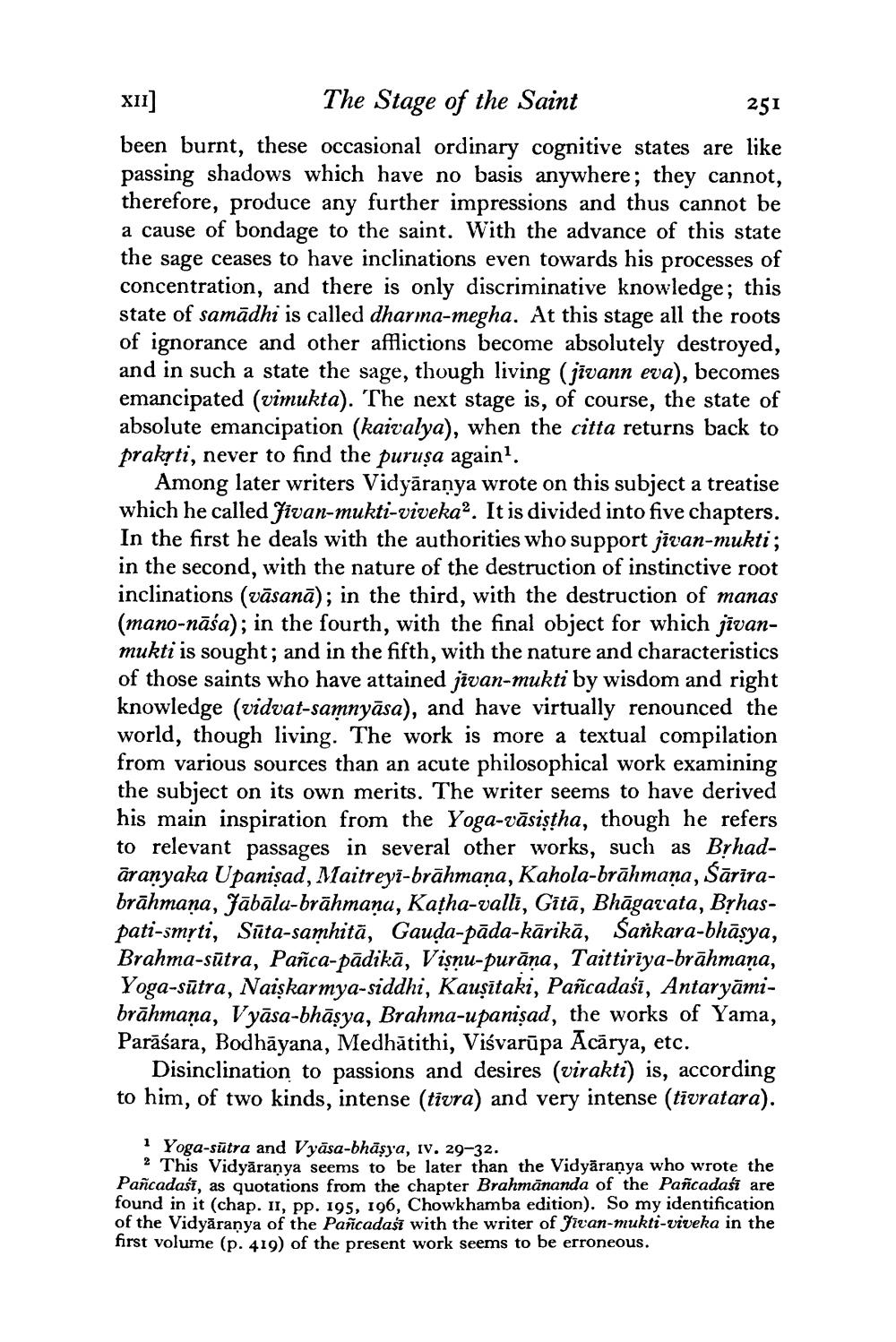________________
X11] The Stage of the Saint
251 been burnt, these occasional ordinary cognitive states are like passing shadows which have no basis anywhere; they cannot, therefore, produce any further impressions and thus cannot be a cause of bondage to the saint. With the advance of this state the sage ceases to have inclinations even towards his processes of concentration, and there is only discriminative knowledge; this state of samādhi is called dharma-megha. At this stage all the roots of ignorance and other afflictions become absolutely destroyed, and in such a state the sage, though living (jivann eva), becomes emancipated (vimukta). The next stage is, of course, the state of absolute emancipation (kaivalya), when the citta returns back to prakyti, never to find the purușa again.
Among later writers Vidyāranya wrote on this subject a treatise which he called Jivan-mukti-viveka?. It is divided into five chapters. In the first he deals with the authorities who support jīvan-mukti; in the second, with the nature of the destruction of instinctive root inclinations (vāsanā); in the third, with the destruction of manas (mano-nāśa); in the fourth, with the final object for which jīvanmukti is sought; and in the fifth, with the nature and characteristics of those saints who have attained jivan-mukti by wisdom and right knowledge (vidvat-samnyāsa), and have virtually renounced the world, though living. The work is more a textual compilation from various sources than an acute philosophical work examining the subject on its own merits. The writer seems to have derived his main inspiration from the Yoga-vāsistha, though he refers to relevant passages in several other works, such as Brhadāranyaka Upanişad, Maitreyi-brāhmaṇa, Kahola-brāhmaṇa, Sārīrabrāhmaņa, Jābāla-brāhmaṇa, Kațha-valli, Gitā, Bhāgatata, Bịhaspati-smrti, Sūta-samhitā, Gauda-pāda-kārikā, Sankara-bhāsya, Brahma-sūtra, Pañca-pādikā, Vişnu-purāņa, Taittiriya-brāhmaṇa, Yoga-sūtra, Naiskarmya-siddhi, Kauşītaki, Pañcadasī, Antaryāmibrāhmaṇa, Vyāsa-bhāşya, Brahma-upanişad, the works of Yama, Parāśara, Bodhāyana, Medhătithi, Visvarūpa Acārya, etc.
Disinclination to passions and desires (virakti) is, according to him, of two kinds, intense (tivra) and very intense (tīvratara).
1 Yoga-sūtra and Vyāsa-bhāsya, iv. 29–32.
2 This Vidyāranya seems to be later than the Vidyāranya who wrote the Pañcadasī, as quotations from the chapter Brahmānanda of the Pañcadasi are found in it (chap. II, pp. 195, 196, Chowkhamba edition). So my identification of the Vidyāranya of the Pancadaś with the writer of Jivan-mukti-viveka in the first volume (p. 410) of the present work seems to be erroneous.




